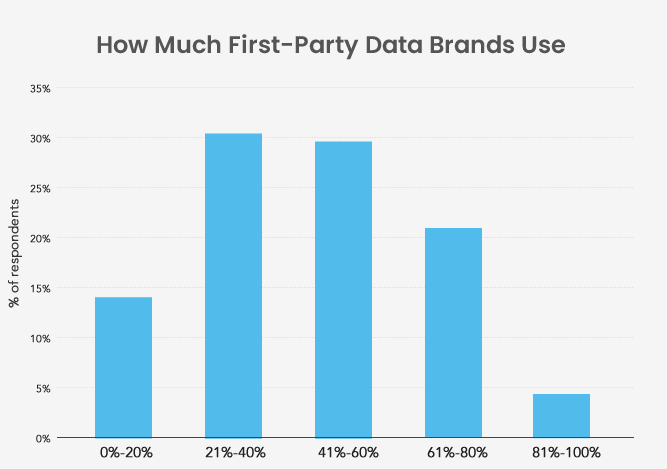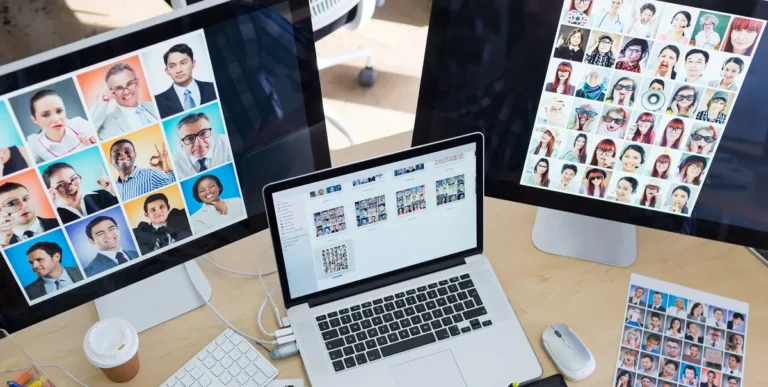Despite the marketing and ad experts (and 90,000 Google search results) proclaiming “third-party data is dead,” we wouldn’t go quite that far. Third-party data still helps enrich your overall understanding of individual consumers.
But there’s a definite industry shift toward gathering and leveraging first-party data — and doing it effectively. That’s the real challenge. In this post, we’ll break down why this trend is happening and what you can do to stay ahead of the curve.
Why Brands Favor First-Party Data
Traditionally, online behavioral advertising depends on third-party cookies. Cookies track users across the internet to get a better picture of their buying interests and intent.
But in many cases, third-party cookies are going away. Privacy concerns have pushed most browsers, representing 87% of browser traffic, to transition away from third-party cookies.
Third-party data is getting more and more difficult to gather as advertisers’ use of data management platforms becomes limited. Referred to as “data deprecation,” there are four driving forces widely considered to be contributing to this trend.
- Operating system and browser restrictions: The third-party cookie restrictions are one example, but this also includes impending limitations on other ad trackers, from mobile ad IDs to proprietary ad identifiers like IDFA. Plus, privacy-first browser settings and features, such as Apple ITP and Firefox ETP, further contribute to data deprecation.
- Data privacy laws: Regulations such as GDPR, CCPA, LGPD and more are designed to protect customer privacy by legally limiting advertisers’ ability to track and store data.
- Widespread adoption of consumer privacy tools: Consumers have become savvier at protecting their own data. They use ad blockers, clear their browsing history and surf in “incognito” or private modes.
- Walled gardens: Customer data bastions, like Facebook, Amazon and Google, have created closed ecosystems where they control customer data, limiting others from accessing its insights.
With third-party data becoming harder to collect, brands have had to rethink their data strategy and put a focus on first-party data.
The First-Party Data Problem
But there’s a gap here. Brands want to use first-party data the right way, but most say they aren’t.
On average, marketers believe they have tapped into only 47% of first-party data’s potential.
Source: Advertiser Perceptions and MightyHive
Often, the problem has to do with planning and execution. Most companies are capable of leveraging first-party data but struggle with getting the right strategy, resources and technological infrastructure in place to collect and use that data effectively.
A New Way to Gather First-Party Data
So what’s a data-driven advertiser or marketer to do?
Go to the source of data: the customer themselves. There’s a right way and wrong way to ask for customer data, but doing it strategically and then using that data judiciously can actually build consumer trust.
When you use consumer data for personalization, such as sharing customized next steps or a personal offer, you’re helping the customer, essentially proving that it’s worthwhile for them to share their data with you.
But sharing data needs to be seamless for the customer. There are two things to keep in mind here:
- Make it easy. You don’t want to send your customer a long survey with nosy questions.
- Add value. Give them a compelling reason to share their data with you. (More on this below.)
Better still, make it fun. That’s exactly what interactive video does. With our fully open Next Generation Video Platform, brands now have a new way to collect and leverage first-party data: Living Video.
Living Video is revolutionizing the world of video by allowing videos to evolve based on the context, data and actions of each viewer. With this new technology, you can send a video to your customers (or prospective customers) and allow them to customize it to their needs. You can then capture that data to deliver more personalized and relevant communications going forward.
A picture is worth A video is worth a million words. Check it out for yourself with this mortgage calculator.
You can input your data and click “Update Video.” Want to play around with different numbers? Just click the bolt icon to update your data.
As you can see in the Living Video above, the user can input data such as their credit score and home value to see an estimated interest rate, APR and monthly payment on their mortgage.
But that’s just one example of data users might share to create customized videos. The applications are nearly limitless. Here are some things a user might want to customize:
- Their name
- Their location
- Number of people to be covered for an insurance plan
- Color or design of a product
- Photos from their recent trip (to create a bespoke travel showreel)
- Their budget for a service
The list goes on.
Once the user enters their information or uploads their media (they can even select the soundtrack), a new video is generated in real-time.
With Living Video in-player customization, everyone wins:
- Data privacy concerns are respected as customers have control over what information they want to share with companies.
- The first-party data they do share helps brands deliver a better experience that helps consumers in real time, enriches the brand’s understanding of their customers and drives business.
Of course, first-party data doesn’t have to mean the viewer inputs data. You might include chapter markers or buttons in your interactive video to let viewers easily navigate to what they need. The forbearance template we created for mortgage companies during the pandemic is one example.
With the viewer directly selecting the next steps that they were most interested in, they were able to receive relevant information in real time. At the same time, the lenders gained valuable information about where their viewers were in the forbearance repayment process, an insight that would help them better communicate with their customers in future.
Another great example is one where users can customize a product they might want to purchase, such as a car.
Viewers can customize the car to their specifications right in the player, as well as get helpful information on purchasing the vehicle, including what their estimated payments would be. At the same time, the company is able to gather first-party data that’ll allow them to better understand consumer demands.
Using First-Party Data in Data-Driven Video
For first-party data to be truly valuable, companies must know how to effectively collect and use that data. The structures and strategies may differ from organization to organization, but overall, here are some general tips to follow when it comes to first-party data.
1) Prioritize data privacy and transparency.
On one hand, this means understanding and strictly adhering to data regulations. More importantly, though, it involves keeping your customers’ trust by ensuring their data is secure.
Ask: What, when, why, and how was the information collected? How is that information stored, analyzed, and used? Ultimately, all aspects of collecting and using customer data should be clearly defined and accounted for.
2) Understand that gathering first-party data is all about fair value exchange.
To maintain a relationship with your customers, companies should be transparently offering something of value in exchange for information. This could be anything from content to a special offer, so long as the customer is getting something in exchange for sharing more about themselves.
3) Look for opportunities for this value exchange across the entire customer journey.
Don’t limit the collection and use of this data to customer acquisition or onboarding efforts. Think about all the different stages of the customer journey that would benefit from first-party data and keep that value exchange going.
4) Leverage video to make an impact.
While there are plenty of ways to use first-party data, data-driven video is particularly effective at getting results. By combining entertainment with relevancy, personalized video has helped brands see a 5x increase in engagement and 8x increase in conversions.
Video is also more shareable. Social video generates 12 times as many shares as images and text combined. When you add in the appeal of customization, users become much more likely to share their personalized video with their network.
Highlighting a customer’s positive experiences with a year-in-review video, for example, is one popular way to strengthen loyalty while increasing brand exposure. See how WW (formerly Weight Watchers) compiled their customers’ wins in a shareable reel. Note that all of this is with first-party data.
It’s Time To Use First-Party Data the Right Way
Curious how first-party data and video can create synergy for your CX? We’d love to talk with you about Living Video, data-driven video and all the ways our platform can support your first-party data strategy. Reach out with questions (we love questions) by scheduling a quick intro call.






